City's $30 million proposal seen as "scientifically naïve"
New York City will monitor all cell site antenna RF levels if proposed legislation passes
October 23, 2009 - New York City's recent introduction of legislation that would require the Department of Buildings to monitor the radiofrequency electromagnetic 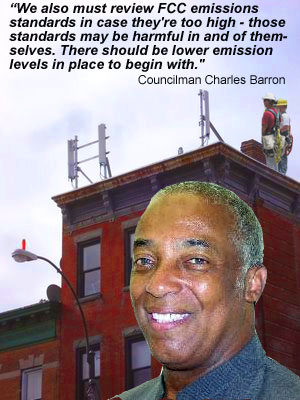 fields emitted by cell site antennas would help legislators to turn down proposed cell sites, according to the bill's sponsor, Councilman Vincent Gentile. fields emitted by cell site antennas would help legislators to turn down proposed cell sites, according to the bill's sponsor, Councilman Vincent Gentile.
If passed, however, it could help to assist in deflecting residents' health concerns if considerably lower than allowable levels of RF are observed.
"Measurements would become public records," said a major mobile carrier asset manager who says his company's sites are operating at considerably lower than the allowable thresholds. "This legislation is designed to get votes and create another bureaucracy in the already bloated DOB," he said.
"They should first consider having a third party tester do a random sampling of sites and identify if any of them exceed federal requirements. If they come up empty-handed, let the public know and end this nonsense," he said.
The bill would require the DOB -- which issues permits for the antennas -- to monitor the radiofrequency radiation emitted by the cell phone antennas in the city every six months, reporting on those whose emissions exceed the federal guidelines.
The president of the New York State Wireless Association, Douglas Dimitroff, believes Gentile's bill is at odds with existing federal regulations and will obstruct the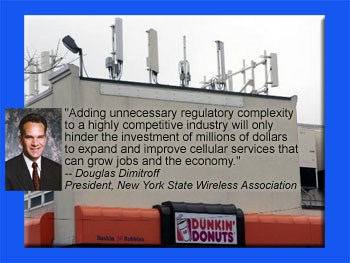 industry's growth. industry's growth.
"The FCC is responsible for regulating RF emissions for licensed carriers and the federal Telecom Act of 1996 prohibits state and local governments from further regulating sites based on RF emissions," said the Buffalo, N.Y. attorney who specializes in telecommunications law.
"Adding unnecessary regulatory complexity to a highly competitive industry will only hinder the investment of millions of dollars to expand and improve cellular services that can grow jobs and the economy," said Dimitroff who is also active in the New York State Telecommunications Association as well as the Site Owners and Managers Division of the PCIA - The Wireless Infrastructure Organization.
Dimitroff said this bill is an issue of significant concern to the NYSWA's membership and its regulatory committee will be taking a closer look at its ramifications.
FCC accused of giving carriers a free ride
One of the biggest problems with the Federal Telecommunications Act of 1996, said Gentile, is that, while antennas are supposed to meet federal emissions guidelines, no one actually checks whether they do. Rather, the companies themselves simply “affirm that the equipment is in compliance with FCC regulations.”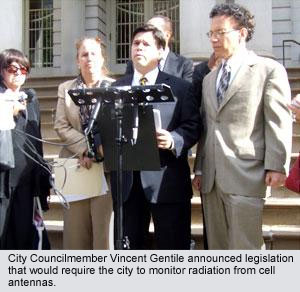
Once they do, Gentile said, they “automatically qualify for the FCC exemption. That prohibits localities from denying the placement of antennas based on health concerns, even though, as he noted, “Health concerns are the predominant complaint we get” about the installations.
Should the bill become law, Gentile said, “I think we will be in a much better position to fight cell phone towers, both those that are proposed and those that are already up,” he informed Helen Klein of the New York Post.
Industry professionals polled said it is doubtful that the legislation could prevent new construction. They noted that a carrier's modeling would identify that their proposed site was in compliance. In order to see if the antennas exceed the FCC’s limits for human exposure to radiofrequency electromagnetic fields, it would have to be built and operational, they said.
Reports on noncompliance of specific antennas derived from the DOB’s oversight would be sent to both the city councilmember and the community board in whose area the antennas in question are located, as well as to the Federal Communications Commission which can issue fines or license forfeitures.
The bill, Intro 1087, does not address contacting OSHA, the agency that has the authority to levy fines and suspend operations if required for compliance.
A call to the DOB to identify how they would administrate the program and what training and equipment their employees would require was not returned. If Gentile's bill passes, inspections will begin July 1, 2010.
Most rooftop sites are compliant by design, so that an individual can walk and not be exposed to RFR above the population/uncontrolled MPE levels. However, a number of them require extensive EME awareness training and expensive equipment for workers so that they can recognize the potential hazards of working in an occupational/controlled exposure.
It is not known how the city's inspectors are going to handle co-located sites where simple detector probes can considerably overestimate field levels in multi-signal environments.
Gentile did not respond to a request as to why he singled out only cell phone carriers and not other RF emitters such as paging, maritime and the city's public works and emergency services antennas that must also follow FCC guidelines for uncontrolled environments.
In addition to the public safety microwave backbone sites, the New York Police Department and the New York City Fire Department antennas are omni directional and work at higher power levels than cellular and PCS antennas.
Gentile's bill did not identify whether the ordinance will require the inspection of antennas on communications towers.
It is expected that wireless carriers' government affairs departments and their lobbyists will be closely monitoring the bill's progress.
"This legislation seems to be a knee-jerk reaction to public misinformation," said a New York site acquisition manager. "It's amazing how truly incorrect some of the comments are in a zoning hearing. Officials know they're false, but don't want to correct them and further inflame their constituency."
Activist legislators can also fuel the RF flames
"This is a very timely bill - we cannot wait for an epidemic to break out due to radiation to protect the citizens of New York City, and this bill does protect them," Councilman Charles Barron said. "We also must review FCC emissions standards in case they're too high - those standards may be harmful in and of themselves. There should be lower emission levels in place to begin with."
The FCC's MPE limits are not local options, and based on exposure limits recommended by the National Council on Radiation Protection and Measurements and, over a wide range of frequencies, the exposure limits developed by the Institute of Electrical and Electronics and adopted by the American National Standards Institute.
“Almost 2,600 new antennas were put up in the city since 2005, and we know that their emissions can be harmful,” Gentile said. “So why aren’t we making sure that the antennae placed next to our families’ homes, children’s schools and public playgrounds follow FCC guidelines?”
"The federal government has abdicated its responsibility to protect us from potentially harmful radiation so we are forced to mandate that the city do this necessary testing to ensure our homes and schools aren't at risk," said Councilman Peter Vallone, a co-sponsor of the bill.
Industry expert says Gentile's proposal is costly and isn't credible
"The proposed legislation is scientifically naïve and quite impractical to implement. It fails on so many points," said Lawrence Behr, CEO of LBA Group, a company that provides RF and wireless telecommunications industry infrastructure products and consulting services.
Behr says the city's point and read plan will do nothing to advance protection from radio frequency exposure and site modeling is a preferable method.
Cautioning legislators, Behr said they should be aware that the cost for a professional on-site inspection and analysis could cost up to $2,000 or more, depending upon how many tenants are co-located on the rooftop.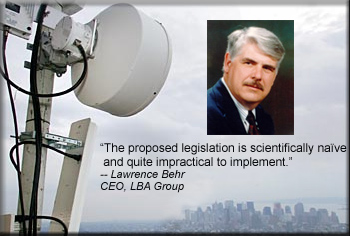
"There exists no radiation standard for emitters. There exist only standards for maximum permissible exposure of people. FCC rules require that any analysis by a licensee must take into account all other licensees contributing radiation to as little as 5% of the MPE at a location," said Behr.
To meaningfully comply with the proposed legislation, he said a cellular operator would need to make measurements which completely encompass all entities transmitting from or near that location. That must include others such as police, fire, broadcast, satellite, WiFi – any system which might possibly contribute in excess of 5% at that location.
"The FCC liability is joint and several. If the cell operator contributes 50%, and 10 other operators contribute 5% each, the cell operator fails," said Behr.
"Their plan is troubling," said Behr who frequently serves as an expert witness before the FCC, the courts and zoning authorities in communications regulatory matters.
"Many antennas do not put out continuous power. Depending on demand, at any instant a cell antenna might be radiating 2% or 100%. Police and fire transmissions are often 'on/off', as are some cellular 'push-to-talk' services. Some antennas wake up only in an emergency, or when an operation is going on in the neighborhood, or when a main site fails."
Behr questioned how the Department of Buildings inspector would coordinate perhaps dozens of transmissions at a site and get every operator to buy into disrupting its operations at the same time.
"And, it even gets worse," said Behr. "Federal MPE standards are based on time and power density. Public MPE standards use a 30 minute window. Even if the maximum value is momentarily exceeded, if the average over 30 minutes is below the limit, the location is compliant. So, point and read measurements can’t be used. If dozens of locations are needed to characterize a rooftop, for instance, each location will need to be recorded for at least 30 minutes. And, for that whole period, all emitters on the roof will need to operate in a known and coordinated manner, disrupting the location for hours or days."
"In truth," Behr said, "virtually all cell carriers and other licensees have studied their RF radiation effects and certified compliance to the FCC. Few cellular systems extend hazardous MPE zones more than a few feet. Once established they tend to be very stable and invariably decrease in power as new, nearby, cells are added."
Contractor believes costs could be staggering
Funding for the additional oversight would come from increasing the permit fees currently paid by telecommunications companies for antenna installations, according to Gentile, but the cost could be prohibitive.
The owner of a New York City telecommunications installation company said when he is installing cell or public safety antennas that oftentimes building residents will voice their anxiety when he is on a roof.
"Most seem concerned that it will radiate or expose them in their apartment. They also ask about the apartment across the street where the antennas are pointing," he said. "Is the DOB going to test in privately owned apartments? In the five boroughs, there is a cell site about every block between all the carriers. There is no way that the government would ever be able to test emission on all of them twice a year. The costs would be staggering, especially in New York City."
Behr agrees, estimating that it would take 20 full-time teams of two year-round to make the two inspections a year at a cost that could swell to $30 million.
The contractor questioned how city workers could accurately perform a test. "Where would they test? Most antennas don’t point straight down to the ground. On a five-story walkup with antennas on the edge of the roof, where do you test? On the street? Under the antennas? A block away? How do you tell which cell site the signal is coming from?"
Older sites could be non compliant, says leasing consultant
Ken Schmidt, President of Steel In The Air, Inc., a cell site lease consulting company for landowners, believes that a small percentage of cell sites in New York City,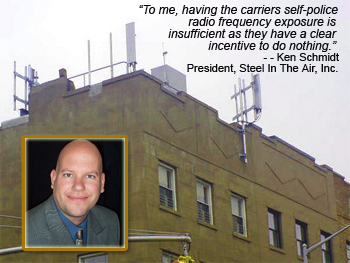 particularly older sites, could be found to be not in compliance with MPE requirements. particularly older sites, could be found to be not in compliance with MPE requirements.
"The compliance could be as simple as marking issues or as complicated as cumulative RFE from multiple carriers. To me, having the carriers self-police radio frequency exposure is insufficient as they have a clear incentive to do nothing. Nonetheless, this proposal by Councilman Gentile is an overly costly and burdensome response."
Schmidt suspects that it will not have the impact of reducing new cell sites and "will expose the city to litigation under the TCA along with the presumptuous comments by Councilman Charles Barron that the City of New York can preempt federal legislation. There have to be more reasonable approaches to the issue - including random checks or reporting requirements by the carriers themselves on a less frequent basis."
"The proposed ordinance creates an open-ended standard - in that it states 'with all standards established by any provision of law applicable to such emissions' without stating whether such standards are federal, state, or local. Thus, the city could create future, more restrictive standards by which the carriers would have to uphold and be subject to monitoring on," said Schmidt.
FCC has voluntary guide to assess RF exposure levels
The FCC and its Local and State Government Advisory Committee have prepared a voluntary guide to assist state and local governments in devising efficient procedures for ensuring that the antenna facilities located in their communities comply with the FCC’s limits for human exposure to radiofrequency electromagnetic fields.
The guide is not intended to replace OET Bulletin 65, which contains detailed technical information regarding RF issues, and should continue to be used and consulted for complex sites.
For additional information about RF compliance, click here.
= = = = = = = = = = = = = = = = = = = = = = = = = = = = = = = =
Intro 1087
A Local Law to amend the administrative code of the city of New York, in relation to the measurement and reporting of emissions from cellular telephone equipment by the department of buildings.
Be it enacted by the Council as follows:
Section 1. Section 28-103.14 of the administrative code of the city of New York is amended by adding a new subsection 28-103.14.2 to read as follows:
§28-103.14.2.
Measuring emissions from cellular telephone equipment.
Commencing on July 1, 2010 and every six months thereafter, the department shall issue a report with respect to the electromagnetic emissions radiating from every cellular telephone service antenna and from all cellular telephone service equipment located within the city and whether the emissions from each such antenna and service equipment are in compliance with all standards established by any provision of law applicable to such emissions. Where it is determined by the department that the emissions from any such antenna or service equipment exceed such standards, the report shall identify the location or locations of such antenna or service equipment and the department shall notify the council member and the community board within whose districts, respectively, such antenna or service equipment is located.
|